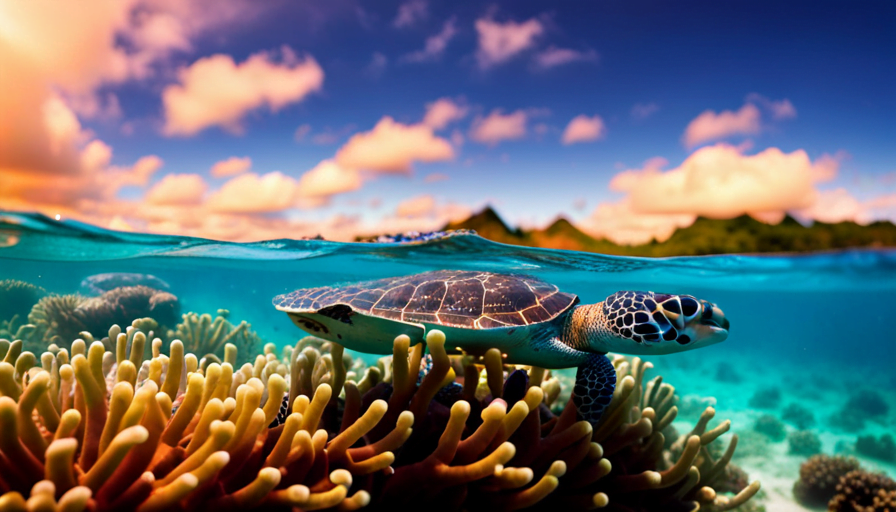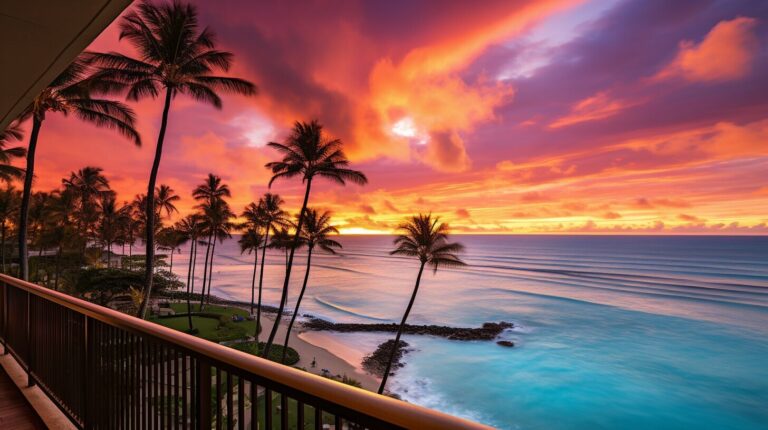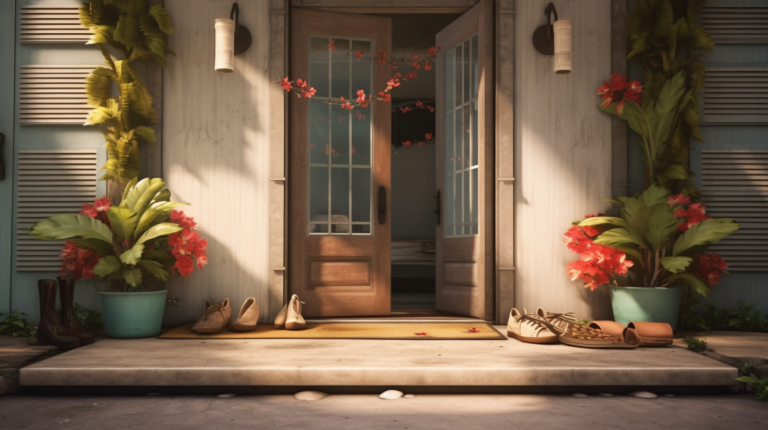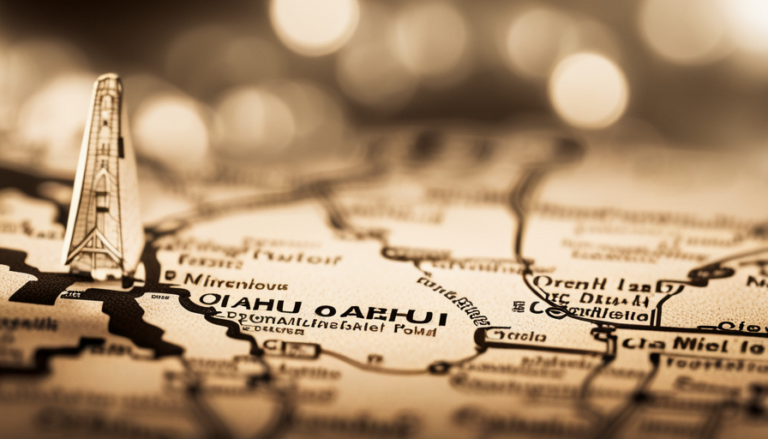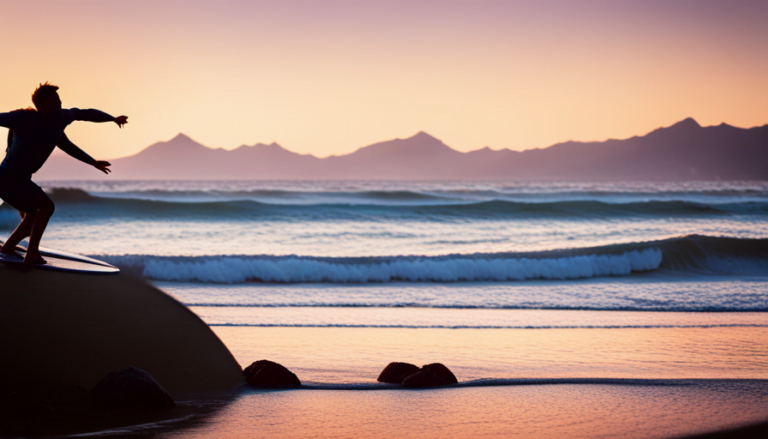🐠 Dive into the Vibrant Marine Life of Oahu 🌊
As a nature lover, you’ll be thrilled to explore the stunning marine life of Oahu. The island is a paradise for snorkelers and scuba divers, as well as those who love to observe sea creatures from shore. The warm, crystal-clear waters of Oahu are home to a diverse range of marine life, from colorful fish and sea turtles to majestic humpback whales.
As you explore the island’s coastal waters, you’ll encounter a vibrant array of fish and other marine life. Schools of yellow tang, butterflyfish, and parrotfish shimmer in the sunlight, while triggerfish and angelfish dart in and out of coral formations. Keep an eye out for the elusive octopus and the giant moray eel, which can both be found lurking in crevices and caves. And if you’re lucky, you might spot a pod of spinner dolphins playing in the waves.
Whether you’re an experienced diver or a first-time snorkeler, you’ll be amazed by the beauty and diversity of Oahu’s marine life.
Key Takeaways
- Oahu is a paradise for snorkeling and scuba diving, with a diverse range of marine life including tropical fish, green sea turtles, and humpback whales.
- Conservation efforts and sustainability practices are in place to protect Oahu’s marine life from threats such as pollution, overfishing, and climate change.
- Whale watching is a popular activity in Oahu, with humpback whales being the most common type of whale in the area.
- Responsible tourism practices, such as reducing plastic waste and supporting local conservation efforts, can help preserve Oahu’s fragile marine ecosystems.
Snorkeling and Scuba Diving in Oahu
Exploring the diverse underwater world of Oahu through snorkeling or scuba diving is an excellent way to witness the beauty of the island’s marine life.
Before embarking on your underwater adventure, it’s vital to prioritize your snorkeling safety by following a few guidelines. Firstly, always check the weather forecast and ocean conditions before heading out. Secondly, never snorkel alone and always use a buddy system. Lastly, it’s important to resist touching or stepping on the coral as it can harm the delicate ecosystem.
If you’re looking to scuba dive in Oahu, there are plenty of scuba gear rentals available on the island. The gear includes a wetsuit, fins, mask, and regulator. You can choose from a range of rental options depending on your level of experience and the duration of your dive. The rental companies also offer scuba diving tours with experienced guides who can take you to the best dive sites on the island.
Once you’re ready to dive in, you’ll be amazed by the colorful fish and other marine life that call the waters of Oahu home. You can spot a variety of tropical fish such as triggerfish, butterflyfish, and parrotfish. In addition to the colorful fish, you can also see green sea turtles, octopuses, and eagle rays.
Witnessing the beauty of Oahu’s underwater world is an unforgettable experience that’ll leave you with a newfound appreciation for the island’s marine life.
Colorful Fish and Other Marine Life
As you dive or snorkel in the beautiful waters of Oahu, keep an eye out for the colorful and diverse marine life that inhabits the area.
Some of the species you may encounter include pufferfish, angelfish, and butterflyfish.
These creatures can be found in a variety of habitats, including coral reefs and rocky outcroppings.
As you observe their behaviors, you may notice unique characteristics such as their intricate patterns and stunning colors.
Species to Look Out For
You’ll want to keep an eye out for the majestic humpback whales during their winter migration to Oahu’s warm waters. These endangered species use the island’s protected bays and shallow waters as a breeding and calving ground. In recent years, conservation efforts have successfully increased their numbers, but they still face threats from human activity such as ship strikes and entanglement in fishing gear.
Another species to look out for is the green sea turtle, also known as honu in Hawaiian. These gentle creatures can often be spotted lounging on Oahu’s beaches, but they also spend much of their time in the water. They are herbivores, feeding on sea grasses and algae, and can live up to 80 years old. Despite being protected under state and federal law, they still face threats from pollution and habitat destruction. Learning about and respecting these amazing creatures is an important step in preserving their habitat and behaviors for future generations to enjoy.
Habitat and Behaviors
To truly appreciate the habitat and behaviors of the humpback whales and green sea turtles, imagine yourself swimming alongside these magnificent creatures in their natural environment.
The humpback whales are known for their acrobatic displays, such as breaching and tail slapping, which can be seen during their migration to Hawaii from Alaska between December and May. While swimming alongside these gentle giants, you may also witness their complex vocalizations, which can carry for miles underwater.
Green sea turtles, on the other hand, are known for their grazing behavior on seagrasses and algae, which can be seen in bays and nearshore reefs around Oahu. These endangered turtles are protected by both federal and state laws, and conservation efforts and sustainability practices are in place to ensure their survival. When swimming alongside these graceful creatures, it’s important to give them space and not disturb their natural behavior.
Humpback whales are known for their acrobatic displays during their migration to Hawaii from Alaska between December and May.
Green sea turtles are known for their grazing behavior on seagrasses and algae in bays and nearshore reefs around Oahu. They are endangered and protected by both federal and state laws.
Conservation efforts and sustainability practices are in place to ensure the survival of Oahu’s marine life.
As you explore the unique characteristics of Oahu’s marine life, you’ll discover the intricate beauty of each species and their importance to the ecosystem.
Unique Characteristics
Swimming alongside humpback whales and green sea turtles is like exploring a vast underwater world full of unique and fascinating creatures. One of the most intriguing aspects of Oahu’s marine life is their physical adaptations. Many species have evolved unique traits to survive in their specific ecological niche. For example, the Hawaiian monk seal has thick fur to keep warm in cold waters, while the octopus has the ability to change color and texture to blend in with its surroundings and avoid predators.
Aside from their physical adaptations, Oahu’s marine life also plays an important ecological role in maintaining the health of the ocean ecosystem. For instance, coral reefs provide a habitat for numerous fish species, and in turn, the fish help to control the population of algae and maintain the health of the reef. Additionally, whales and other large marine mammals transport nutrients across vast distances, helping to fertilize and support the growth of phytoplankton.
Understanding the unique characteristics and ecological importance of Oahu’s marine life is crucial for conservation efforts and ensuring the long-term health of the ocean ecosystem.
As we transition into the subsequent section about sea turtles of Oahu, it’s important to note that these gentle giants also play a vital role in the ocean ecosystem.
Sea Turtles of Oahu
Don’t miss the chance to see the fascinating sea turtles that inhabit the waters surrounding Oahu. These magnificent creatures are a sight to behold, with their impressive size and graceful movements. Oahu is home to several different species of sea turtles, including the Green Sea Turtle and the Hawksbill Turtle.
Conservation efforts have been instrumental in protecting the sea turtle populations of Oahu. These efforts have included measures such as restricting fishing practices that harm turtles and educating the public about the importance of preserving their habitats. Thanks to these efforts, the sea turtle populations on Oahu have been slowly recovering in recent years.
Sea turtles have unique nesting habits, with females returning to the same beaches where they were born to lay their eggs. If you’re lucky, you may even get to witness a sea turtle nesting on one of Oahu’s beaches. However, it’s important to remember to keep a respectful distance and avoid disturbing the turtles, as they are a protected species.
As you explore the waters around Oahu, keep an eye out for these amazing creatures. But don’t forget that the marine life on Oahu doesn’t stop with sea turtles – next up, we’ll explore the exciting world of whale watching.
Whale Watching
If you’re interested in observing the annual migration of humpback whales, Oahu offers several seasonal whale watching opportunities.
These majestic creatures can be spotted from December to May, as they traverse between their summer feeding grounds in Alaska and their winter breeding grounds in Hawaii.
While humpback whales are the most common type of whale in Oahu’s waters, you may also be lucky enough to spot other species such as pilot whales, killer whales, and beaked whales.
To maximize your chances of observing these magnificent animals, it’s recommended to join a guided tour or rent a boat with experienced crew members.
Seasonal Whale Watching Opportunities
You’ll be mesmerized by the majestic humpback whales that migrate to Oahu’s waters during the winter months, providing a thrilling seasonal whale watching opportunity. From November to May, these gentle giants travel from Alaska to Hawaii to mate, give birth, and nurse their young in the warm, shallow waters surrounding the island. During this time, you can witness their impressive displays of breaching, tail slapping, and singing.
To ensure the best viewing experience, head to the island’s west coast where the whales are most frequently spotted. Makaha Beach, Yokohama Bay, and Kaena Point offer panoramic views of the Pacific Ocean and are popular among locals and tourists alike. Whale watching tours are also available, providing a unique perspective and the chance to get up close and personal with these magnificent creatures. Now, let’s dive into the different types of whales you may encounter on your Oahu adventure.
Types of Whales in Oahu
Now that you know when to go whale watching in Oahu, let’s talk about the types of whales you can expect to see.
Oahu is home to a diverse whale population, with the most common types being humpback whales and pilot whales. Humpback whales are the stars of the show during whale watching season, as they’re known for their acrobatic displays and haunting songs. These massive creatures can grow up to 50 feet long and weigh up to 40 tons.
Pilot whales, on the other hand, are smaller and more elusive, often staying closer to shore than their humpback counterparts. Whale watching tours in Oahu provide a great opportunity to see these majestic creatures up close and personal. As you prepare for your whale watching excursion, it’s important to remember that these animals are wild and should be respected from a safe distance.
Now, let’s move on to the best ways to observe them.
Best Ways to Observe Them
Ready to get a front-row seat to the incredible display of acrobatics and songs put on by humpback and pilot whales in Oahu? Let’s dive into the best ways to observe these majestic creatures!
Firstly, underwater photography is a great way to capture the beauty of these magnificent creatures. You can rent or buy underwater cameras or GoPros and take them on your snorkeling or diving trips. With the right equipment and some practice, you can capture stunning shots of the whales swimming, breaching, and singing underwater.
Secondly, glass bottom boat tours are a convenient and comfortable way to observe the whales without getting wet. You can sit back and relax while watching the whales swim under the boat. The tours are led by experienced guides who can provide you with interesting facts about the whales and their behavior.
Lastly, if you are lucky enough to see the whales from the shore, remember to keep a safe distance of at least 100 yards. Do not approach them in boats or try to swim with them as it can disturb their natural behavior.
As much as it’s fascinating to observe these creatures, it’s equally important to protect and conserve their natural habitat. Marine conservation in Oahu is a crucial topic that we’ll delve into next.
Marine Conservation in Oahu
If you’re interested in marine life, it’s important to understand the threats that it faces in Oahu. Pollution, overfishing, and climate change are among the biggest issues.
But there are also local conservation efforts underway to protect the island’s marine species, including coral reefs and sea turtles. If you want to get involved, there are opportunities to volunteer with organizations like the Hawaii Wildlife Fund or to support sustainable fishing practices.
Threats to Marine Life
Problems persist for Oahu’s marine life due to pollution, overfishing, and habitat destruction. Pollution prevention strategies have been implemented, such as reducing plastic waste and implementing stricter regulations on sewage discharge. However, there is still a long way to go in mitigating the effects of pollution on the marine ecosystem.
Overfishing is also a major issue, as many species of fish are being caught at unsustainable rates. Solutions to this problem include implementing fishing quotas and promoting sustainable fishing practices.
In addition, habitat destruction from development and coastal erosion also poses a threat to marine life. It’s important to address these threats and work towards preserving the delicate balance of Oahu’s marine ecosystem.
Moving forward, local conservation efforts play a crucial role in protecting and restoring the island’s marine life.
Local Conservation Efforts
Let’s take a look at how locals are actively working to preserve and protect the beautiful ecosystem surrounding the island. Oahu’s marine life is an invaluable asset to the community, and many organizations and groups are dedicated to promoting marine education and conservation efforts.
One such organization is the Oahu Marine Life Conservation Society, which focuses on marine education and conservation through community outreach. They offer educational programs to schools and community groups, as well as organize beach cleanups and other conservation efforts. Through their efforts, they hope to inspire a new generation of nature lovers and conservationists who will work to preserve and protect Oahu’s marine life for years to come.
Now that you know about the local conservation efforts, it’s time to learn how you can get involved in preserving and protecting Oahu’s marine life.
How to Get Involved
Wondering how you can contribute to the preservation of the beautiful ecosystem surrounding the island? Here are some easy ways to get involved in conservation efforts!
Look for volunteer opportunities: There are a number of organizations in Oahu that are dedicated to preserving marine life. Joining one of these groups is a great way to learn more about conservation efforts and to connect with like-minded individuals who care about the environment. Some options include Hawaii Wildlife Fund, Hawaii Marine Animal Response, and the Surfrider Foundation.
Support community initiatives: Many local businesses and organizations are working to reduce their impact on the environment. You can support these efforts by choosing to shop at eco-friendly stores, participating in beach cleanups, or attending educational events about water conservation and pollution prevention.
Practice responsible tourism: As a visitor to the island, you can make a difference by making responsible choices during your stay. This can include choosing eco-friendly accommodations, supporting sustainable tourism practices, and minimizing your use of single-use plastics.
Spread the word: Share your passion for marine conservation with others! Talk to your friends and family about the importance of preserving Oahu’s marine life, and encourage them to get involved in conservation efforts as well.
Now that you know how to get involved in conservation efforts, it’s time to explore the beautiful beaches and coastal walks of Oahu.
Beaches and Coastal Walks
Explore the stunning beaches and coastal walks of Oahu and immerse yourself in the diverse marine life that thrives in these habitats. As you stroll along the shoreline, you’ll witness the effects of coastal erosion and beach restoration efforts that have taken place to preserve these natural wonders.
Oahu’s beaches are among the most beautiful in the world, but they are also fragile ecosystems that require our protection and care. Take a walk along Lanikai Beach, a breathtaking stretch of sand that offers crystal-clear waters and excellent snorkeling opportunities. Here, you can spot an abundance of colorful fish, sea turtles, and even dolphins if you’re lucky.
For a more adventurous experience, head to Kaena Point on the North Shore, where you can hike along a coastal trail that leads to a secluded beach. Along the way, you’ll encounter tide pools, rocky cliffs, and stunning views of the ocean.
As you explore Oahu’s beaches and coastal walks, it’s important to keep in mind the impact that tourism has on these fragile ecosystems. Sustainable tourism practices, such as reducing plastic waste and supporting local conservation efforts, can help ensure that these natural wonders are preserved for future generations to enjoy.
So, take a moment to appreciate the beauty of Oahu’s marine life, and consider how you can help protect it.
Sustainable Tourism
You can make a positive impact on your travels by choosing sustainable tourism practices. One way to do this is by staying in eco-friendly accommodations that prioritize reducing their environmental footprint. These accommodations may use renewable energy sources, implement water conservation practices, and reduce waste through recycling and composting programs. By choosing to stay in these accommodations, you can support their efforts to be environmentally responsible and reduce your own impact on the planet.
Another way to practice sustainable tourism is to support responsible marine tourism initiatives. This may involve taking tours that prioritize the protection of marine life and their habitats, such as ones that don’t disturb nesting sea turtles or that use eco-friendly boats. You can also support local conservation efforts by donating to organizations that work to protect marine life and their habitats, or by participating in beach clean-ups and other community events.
Although sustainable tourism practices may require some initial adjustments and may come at a slightly higher cost, the benefits are clear. By reducing plastic waste and supporting local conservation efforts, you’re helping to protect the marine life and habitats that make Oahu such a unique and beautiful place. By making sustainable choices, you can enjoy your travels while also making a positive impact on the environment.
Conclusion
Congratulations, nature lover! You’ve now become an expert on Oahu’s marine life.
Snorkeling and scuba diving in Oahu’s clear waters will give you the chance to observe the colorful fish and other marine life up close. You might even come across the majestic sea turtles that reside in these waters.
But it’s not just about the fun and excitement of seeing these creatures. It’s also important to understand the importance of marine conservation in Oahu. This beautiful island is home to a rich and diverse marine ecosystem that needs to be protected for future generations.
One way to do this is by practicing sustainable tourism. As you explore the beaches and coastal walks, remember to leave only footprints and take only memories. Your actions can make a significant impact on preserving the natural beauty of Oahu’s marine life.
Just like the ebb and flow of the ocean tides, the beauty and fragility of Oahu’s marine life is a delicate balance. It’s like a precious pearl that needs to be protected and cherished.
So, as you continue your journey as a nature lover, remember that you have the power to make a difference in the preservation of Oahu’s marine life. Let’s work together to keep this pearl shining for generations to come.

